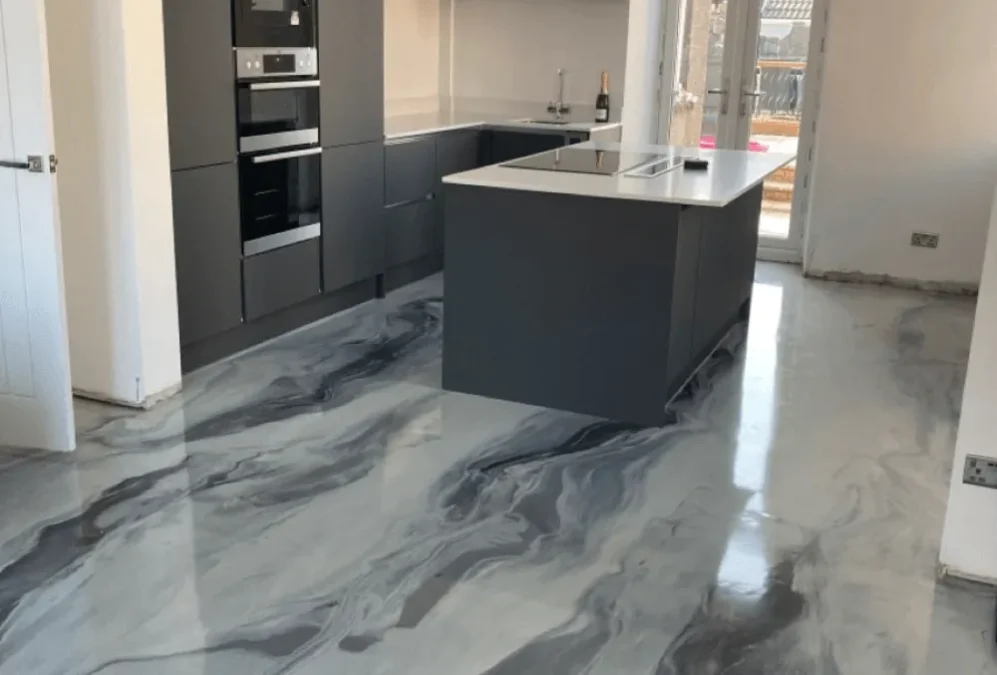Epoxy Flooring: A Comprehensive Guide to Durable and Stylish Flooring Solutions?

Epoxy flooring is one of the most popular choices for residential, commercial, and industrial spaces, known for its durability, versatility, and aesthetic appeal. As resin-based flooring, epoxy is applied as a liquid that hardens into a seamless, glossy surface. It’s a practical solution for various environments, from garages to warehouses and even kitchens. This article explores epoxy flooring, its benefits, types, installation process, maintenance tips, and why it’s a wise investment for various applications.
What is Epoxy Flooring?
Epoxy flooring is a surface covering created by layering a hardening resin over a floor base, which can be concrete or another material. This mixture of epoxy resins and hardeners creates a chemical bond that results in a firm, protective layer. The final outcome is a smooth, firm surface that can withstand heavy loads, high traffic, and chemical exposure, making it ideal for spaces that need a robust, resilient floor.
Benefits of Epoxy Flooring
- Durability
Epoxy flooring is incredibly durable and resistant to wear and tear. It can last several years without cracking or peeling, even under heavy usage. This longevity makes it ideal for industrial plants, garages, and warehouses.
- Easy Maintenance
Epoxy floors are seamless, so they don’t trap dirt or dust, and spills can be wiped up easily. This feature makes them low-maintenance compared to other flooring types, especially in environments where cleanliness is crucial.
- Aesthetic Appeal
With various colours, finishes, and patterns available, epoxy flooring can enhance the look of any space. High-gloss options provide a sleek, polished look that reflects light, brightening up rooms. There are also options for matte or textured finishes, giving a space a unique appearance.
- Chemical Resistance
One key reason epoxy is used in industrial settings is its ability to withstand chemicals without degrading. This is especially valuable in laboratories, garages, and manufacturing facilities.
- Safety Features
Epoxy flooring can be customized with anti-slip additives, which increase traction and reduce the risk of accidents. Additionally, the glossy finish can make the floor highly visible, an essential factor in safety-conscious settings.
Types of Epoxy Flooring
- Self-Levelling Epoxy Flooring
This type of epoxy is ideal for spaces with uneven or damaged surfaces. Self-leveling epoxy creates a smooth and seamless surface, making it popular in commercial and industrial settings. It’s also used in homes, especially in basements and kitchens.
- Epoxy Mortar Flooring
Epoxy mortar flooring is the most robust option. It consists of a mix of 100% solid epoxies and graded sand or quartz. It’s perfect for areas that require an extremely durable surface, such as manufacturing plants or warehouses.
- Epoxy Terrazzo Flooring
Epoxy terrazzo is a decorative flooring type that combines epoxy resin with small pieces of marble or granite. This option offers a unique and luxurious look and is often used in hotels, lobbies, and high-end retail stores.
- Quartz-Filled Epoxy Flooring
This type of epoxy includes quartz grains within the resin, adding texture and providing a slip-resistant surface. It’s commonly used in restrooms, locker rooms, and other spaces where water might be present.
- Anti-Static Epoxy Flooring
Anti-static epoxy is specially designed to prevent static electricity, which can be hazardous in environments that handle flammable materials. It’s ideal for laboratories, hospitals, and electronics manufacturing facilities.
Epoxy Flooring Installation Process
Step 1: Surface Preparation
Surface preparation is essential to ensure proper adhesion. This involves thoroughly cleaning the surface and removing grease, oils, or dirt. Any cracks or imperfections are filled and levelled.
Step 2: Applying the Primer
A primer layer is applied to the floor to create a strong bond between the epoxy and the substrate. The primer also helps to prevent air bubbles from forming in the final layer.
Step 3: Mixing the Epoxy Components
Epoxy flooring consists of two parts – resin and hardener. These components are mixed in the correct ratio and stirred thoroughly to activate bonding.
Step 4: Application of the Epoxy
Once the mixture is ready, it’s poured onto the surface and spread evenly using rollers or squeegees. Depending on the type of epoxy floor, this may involve multiple layers to achieve the desired thickness and finish.
Step 5: Curing
After application, the epoxy needs time to cure, ranging from 12 to 48 hours, depending on the product and environmental conditions. The floor should be kept free of dust and moisture during this period.
Maintenance Tips for Epoxy Flooring
- Regular Sweeping and Dusting
- Keeping the surface free of dirt and debris prevents scratches, and the floor looks polished.
- Avoid Abrasive Cleaning Tools
- Use soft brushes or mops to clean the floor to avoid scratching the surface. For tough stains, a mild detergent can be applied without affecting the epoxy coating.
- Use Mats at Entryways
- Placing mats at entrances helps reduce the amount of dirt and debris brought onto the floor.
- Promptly Clean Spills
- Cleaning spills quickly is essential to prevent any potential stains, especially with strong chemicals.
- Schedule Periodic Deep Cleaning
- A thorough cleaning every few months will maintain the epoxy’s shine and ensure the floor remains in good condition.
Epoxy Flooring Costs
The cost of epoxy flooring varies depending on the type of epoxy used, the size of the area, and the complexity of installation. Generally, self-levelling epoxy costs less than epoxy terrazzo, and a basic solid-colour finish will cost less than a decorative, multi-coloured finish.
The cost of residential installations typically ranges from $3 to $12 per square foot, while commercial and industrial installations might cost between $5 and $15 per square foot due to the additional durability requirements.
Is Epoxy Flooring Worth the Investment?
Epoxy flooring is an investment that provides long-term benefits, especially in high-traffic areas. Its durability, ease of maintenance, and resistance to various factors make it suitable for residential and commercial applications. Compared to other flooring options like tile, carpet, or hardwood, epoxy flooring requires less upkeep and a significantly longer lifespan.
Conclusion
In conclusion, epoxy flooring is a versatile, durable, and aesthetically pleasing solution suitable for various environments. Whether used in a home garage, a commercial kitchen, or an industrial facility, epoxy flooring offers benefits that are hard to match with other flooring options. By understanding the types, installation process, maintenance requirements, and costs associated with epoxy flooring, you can decide whether this flooring solution meets your needs. For those seeking a resilient, stylish, and low-maintenance floor, epoxy flooring is undoubtedly a worthwhile investment.



